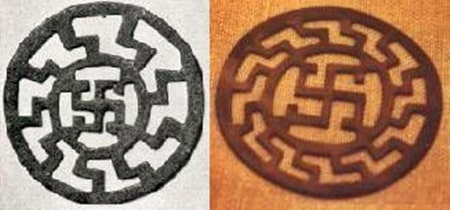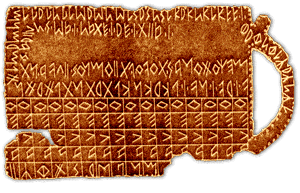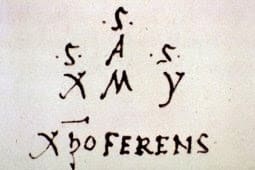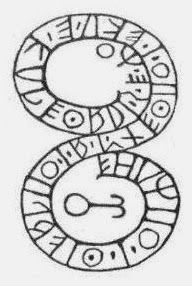
Black Sun Rising VI, 1… the Black Madonna and the Swastika
by Jack Heart & Orage
First published July 15, 2014, Veterans Today
With originally 5828 Views
They tell us that two thousand years ago the Roman Empire sent twenty thousand men, three legions, into the forbidding swamps of Germania’s Teutoburg Forest. The legions, as of yet invincible, were elements of the most powerful military force the world would see till the rise of the British Empire. They were there to fight a punitive action against the Germanic tribes who were reticent about joining Rome’s empire.

The Romans had been tricked onto terrain unsuitable for their style of battle by their own ally, a trusted German nobleman named Arminius who had been raised amongst the Romans and groomed to unite Germania’s feuding warlords under the banner of Empire. Inexplicably, Arminius had known seemingly from the start that he would oppose his Roman mentors. The reward for his loyalty to the tribes would be his murder at their hands a decade later and it never could have ended any other way. But he led the rebellion regardless.
Not one legionnaire would leave the Teutoburg Forest alive. For the next millennium, Germania would remain free, independent of Empire and isolated from the Christian pestilence that would eventually destroy Rome and plunge the western world into the Dark Ages. *
Arminius was born into the Cherusci tribe, the preeminent tribe in northwestern Germania. Because of lingual differences from the surrounding Germanic tribes they have been linked by scholars to an enigmatic and ancient Indo-European tribe known as the Veneti. Over three hundred Venetic inscriptions have been translated.

According to alleged Roman historian; Titus Livius (Livy), said to be native to the region, the Veneti originally settled northern Italy by way of Troy. The inscriptions show they worshipped a Goddess whom they called Reitia. Their alphabet is similar to the Etruscans who bordered them to the Southwest.
There is Mitochondrial DNA evidence linking Northern Italians, Nordics and the Dene speaking tribes of America to each other and what then would have been ancient Sumer. Haplo group X is the recurring genetic marker found in these diverse peoples. Its particularly prevalent in the Druze, a minority population in Israel, Jordan, Lebanon, and Syria but it is also found in Northern Europeans who were the ancestors of the Celts.
Northern Europeans can be linked directly to Egypt through the Nebra sky Disk. Additionally Haplogroup X is found in concentrations in the area of Italy that once comprised the land of the Etruscans; the progenitors of Rome. The Etruscans trace their own origins back to the Minoans who wrote in Linear A now popularly excepted by scholars to be an early form of Semitic.
Among Native Americans, Haplogroup X appears in northern Amerindian groups, including the Ojibwa, the Nuu-Chah-Nulth, the Sioux, the Yakima, and the Na-Dene–speaking Navajo.The homogeneity of the Dene sequences suggests that they acquired Haplogroup X relatively recently, about 1000 years ago. The sequence data and Phylogenetic analysis suggest that the Native American and non-Asian Old World Haplogroup X mitochondrial DNA’s share a common maternal ancestor but also suggest that they diverged from each other 31,000–36,000 years ago, originating in the Old World and migrating into America. Haplogroup X is most conspicuous by its absence from Siberia much like the Clovis Spear Point.
In the third part of this essay we presented the evidence, which has been suppressed at all costs, that the Maya built and lived in Tikal without even disturbing the surrounding jungle let alone using tools, the same way the Talmud tells its readers the first temple was built. The Maya vanished in an orgy of violence and a few years later their traditions of cannibalism, human sacrifice and even their favorite ballgame, played with a human head, would be duplicated by the Anasazi of the Southwest. **
With the recent introduction onto the academic playing field of the Disturnell Map, presumably even the most incorrigible of National Geographics fans have finally gotten it straight. The map is connected to the 1848 Treaty of Guadalupe Hidalgo and shows three migration points depicting the southerly migration route of the Aztec beginning in Utah.
The distribution from Canada to South America of the Uto-Azteca language, the dietary consumption of both corn and human flesh, and the very existence of the Anasazi themselves make it a forgone conclusion for any scholar not sucking up to the academic grant trough that the Aztecs migrated into the Mexican valley from the Great Salt Lake area and the land of the Anasazi. (1)
That the Aztecs were the Anasazi is the logical scientific conclusion but unfortunately for scientific empiricism that same blood-soaked land is now occupied by the Mormons. The Mormons Masonic and Jewish affiliations are well documented as is their penchant for adjusting history to suit what they believe to be the revelations of the angel Moroni.(2)

The unspeakable truth is when the cannibalistic Aztec swarmed into the Mexican valley less than a thousand years ago they, or at least the cadre of the Sumerian priesthood that was their evil core, were exercising their biblical “right of return” to their Mayan homeland. And it was they and their Vatican cleanup crew of conquistadors that laid Mesoamerican civilization to waste and saw to it that the codex’s and even time itself were erased, all in an effort to cover their diabolical tracks. It may be just a coincidence, but the tribal names Anasazi and Ashkenazi are almost identical.

“Columbus” hooked X signature marks him as a Knight Templar for posterity. He came to America expecting to contact remnants of a Sumerian civilization. He brought with him Luis de Torres; a Chaldean interpreter, and most likely the enigmatic Crónica X too. (3)
Crónica X, a fabled pre-Columbian book about Mesoamerican civilization, would have been compiled by the Knights Templar during their prior almost three-hundred-year exclusive access to the Potosí silver mine in Bolivia and the entire east coast of the Americas discussed in Black Sun Rising I.
It’s said Livy wrote extensively on the history of Rome during the reign of Augustus Caesar. Although his monumental History of Rome is all that is known to have survived of his work, Livy was used as a source for many of the historians who came after him. Julius Obsequens would use him as his source to write the Book of Prodigies an account of the supernatural events attendant to the founding of the Roman Empire between 249 BCE to 12 BCE.
Writing of the year 100 BCE Obsequens says, “When C. Murius and L. Valerius were consuls, in Tarquinia towards sunset, a round object, like a globe, a round or circular shield, took its path in the sky from west to east.” According to academics by 100 BCE Rome had just successfully concluded the over a decade long Cimbrian War with the Nordic tribes over who would rule the Italian peninsula. It had been a series of pitched battles between massive armies in which both sides had inflicted over a hundred thousand dead on the other in different engagements.
In the history of Rome they fight their Civil War in 91 BCE. The war has been dubbed the Social War by historians. Obsequens writes “At Aenariae, while Livius Troso was promulgating the laws at the beginning of the Italian war, at sunrise, there came a terrific noise in the sky, and a globe of fire appeared burning in the north. In the territory of Spoletum, a globe of fire, of golden color, fell to the earth gyrating. It then seemed to increase in size, rose from the earth and ascended into the sky, where it obscured the sun with its brilliance. It revolved toward the eastern quadrant of the sky.” In the Social War Rome’s allies on the Italian peninsula would win equal citizenship in the emerging Roman Empire.
Obsequens also records seemingly random Fortean phenomena like this description of what for all intents and purposes sounds like a rocket launch; in 42 BCE “something like a sort of weapon, or missile, rose with a great noise from the earth and soared into the sky.” The Book of Prodigies would first be published in 1508 in Venice by printing press pioneer Aldus Manutius. It is in Venice, at that same time, which our story begins.

It’s said that the Veneti had fought at the side of Rome since the Punic Wars and after the Social War they had become citizens. So for all intents and purposes since time out of mind the Veneti have spoken Latin, and all that’s really known of them comes from sparse and highly disputed translations of inscriptions to a forgotten Goddess. (4)
As academic history goes In the Fifth Century the Veneti would be overrun by the Visigoths and the Huns and in the Sixth invaded and occupied by the Lombardi. A small strip on the coast containing the ever-expanding island city of Venice was all that remained under the control of Constantinople, Rome’s heir in the East and the heart of the Byzantine Empire.
In the beginning of the Eighth Century Venice threw off the Byzantine yoke and began electing its own leader taking great pains to develop an ever increasingly complicated electoral process which limited the influence of any one family. This elected ruler called Doge served for life.
At the beginning of the Ninth Century what was then the embryo of the Venetian Republic successfully resisted Charlemagne and his pope, causing the death of Charlemagne’s son Pepin; “king of Italy,” in the process. By the latter half of the Twelfth Century the prosperous cities of the region would form an alliance…